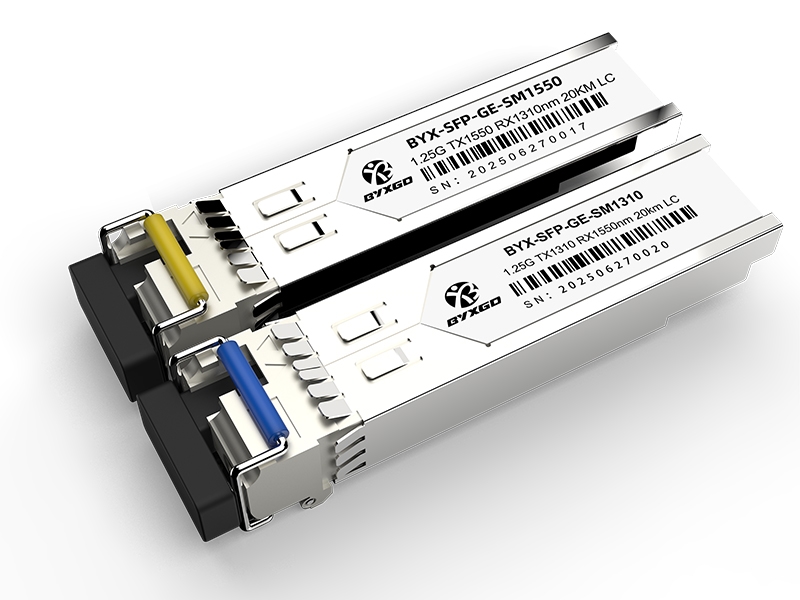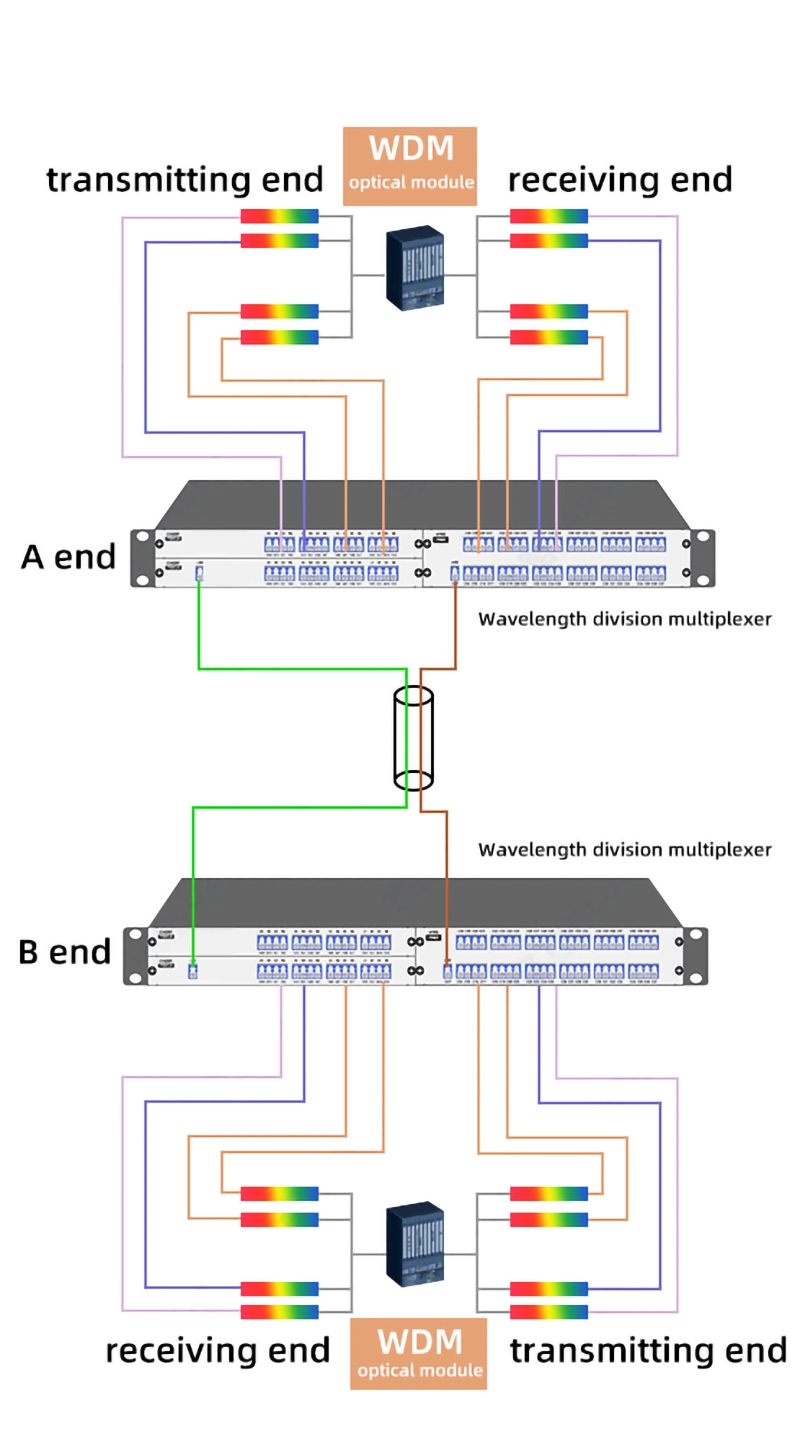BiDi Optical Modules: Unlocking Single-Fiber Bidirectional Connectivity

Low on fiber but need faster and more dependable connections? What if you could double your network’s capacity without having to add any additional fiber? BiDi optical modules can do this by utilizing full-duplex communication over a single fiber strand via two wavelengths. By reading this blog, you will understand how SFP BiDi technology allows you to save fiber, reduce costs, and simplify installation while enabling your network to increase bandwidth and faster connectivity.
Why Choose BiDi? Solving Your Fiber and Cost Challenges
BiDi modules are transceivers that can send and receive at the same time over one fiber cable using two wavelengths. This full-duplex allows both directions without requiring a separate fiber for receiving. BiDi modules can provide a reduction in fiber usage by over fifty percent, which is a benefit in combating fiber shortages.
For network operators that have budgets to manage, deploying SFP BiDi modules allows for reduced fiber usage, versus leasing or installing new fiber lines, thereby maximizing the existing cabling. This improves not only reallocating certain recurring expenses like fiber leasing but also the costs of installation and maintenance provided by a fiber connection.
In real-world situations, bidirectional SFP modules are a solution for 50% fiber usage savings in campus networks, metro rings, and data center interconnects. For example, a company using multiple 10G links needed to reduce its overall fiber consumption by 50%. They cut their optical module costs and improved the cabling management in the same stroke.
The benefits of deploying fiber-saving SFP modules do not stop with cost reduction. Fewer physical connections to manage lead to faster deployments and fewer potential failure points. The fiber efficiency has a positive streamlining effect on network upgrades and expansions without considerable economic or operational delay.
In conclusion, BiDi optical transceivers are a sound and cost-effective solution for a network looking to increase capacity but prefers not to buy or lease new fiber. They provide cost savings, augmented deployment, and increased efficiency with limited but valuable fiber resources.

How Dual Wavelengths Enable Single-Fiber Bidirectional Transmission
Bidirectional (BiDi) optical modules utilize wavelength division multiplexing/wavelength selective coupling (WDM) technology to provide simultaneous transmit and receive capability over a single fiber strand. This technology utilizes two different wavelengths, typically 1310 nm for the Transmit (Tx) wavelength and 1550 nm for the Receive (Rx) wavelength, to transmit data in both directions without interference.
You can think of this as a two-way radio conversation, where the conversation happens at two different frequencies. One frequency carries out the outgoing messages while the other frequency receives the incoming signal. Again, like a two-way radio conversation separated at two different frequencies, the single fiber operates as a two-lane road allowing full-duplex communication without needing additional fibers and the associated costs.
An important design factor of the BiDi SFP transceiver is optical isolation, as this can help avoid crosstalk between the Tx and Rx wavelengths. In other words, it is important to ensure that the signals do not interfere with one another, thus maintaining data integrity. Transceivers will use an integrated filter or wavelength downward component to effectively isolate the Tx and Rx wavelengths.
The duplex operational mechanism inside the BiDi optical module will multiplex/demultiplex the wavelengths using a built-in WDM multiplexer/demultiplexer. The integrated component provides the ability to combine the Tx and Rx optical signals onto a single fiber while simultaneously separating them at the receiving end, minimizing cabling, thereby reducing point-to-point connections.
BiDi Optical Transceiver Characteristics and Operation
Typical BiDi optical transceiver wavelengths are fixed, and to preserve compatibility between a Tx and Rx module with respect to wavelengths, the Tx for one module may transmit a wavelength of 1310 nm, while the paired module transmits a 1550 nm wavelength, thus the Tx/Rx transition. Correct pairing of the two optical wavelengths is essential for proper BiDi link operation.
Not only do BiDi modules offer stringent and specific wavelength accuracy, but they also meet stringent optical power budgets to allow distances up to and beyond 40 km depending on the type of module. The optical parameters balance for signal strength, noise, and fiber attenuation all come together to ensure that the modules can transmit effectively.
Paired BiDi modules multiplex and demultiplex the two wavelengths onto a single fiber, allowing for simultaneous bidirectional data flow effectively. This practical design reduces cabling complexity while demonstrating the power of a single fiber used bidirectionally.
Ultimately, bidirectional optical transceivers are a function of smart wavelength management, combined with robust engineering, that can frequently maximize the utility of fiber while simplifying network architecture. The duplex fiber-saving capability is always attractive to carriers, enterprises, and data center networks seeking economical bandwidth expansion.

Multi-Speed Application: BiDi Modules in 1G to 100G Networks
BiDi modules are available for different network speeds from 1G to 100G with all the fiber savings. They can offer diversity in fiber counts in both local area networks (LANs) and data center interconnects (DCI) and hyperscale data centers that require ultra-high bandwidth.
Below is a comparison of common BiDi transceiver types:
| Module Type | Typical Application | Tx/Rx Wavelengths (nm) | Max Link Distance | Key Advantages |
| 1G BiDi SFP | Campus, access networks | 1310/1550 | Up to 20 km | Cost-effective fiber saving |
| 10G BiDi SFP+ | Metro, DCI | 1310/1550 | Up to 40 km | Balance of speed and cost |
| 25G BiDi SFP28 | Hyperscale data centers | 1310/1550 | Up to 40 km | Higher speed with fiber efficiency |
| 100G BiDi QSFP28 | DCI, large-scale data centers | 1310/1550 | Up to 10 km | Ultra-high speed, compact form |
The 1G BiDi SFP is designed for the lowest possible cost in very cost-sensitive campus deployments, while still allowing for fiber-optic reductions and easy implementation. The 10G BiDi SFP+ modules are also applicable to metro networks, as well as for mid-sized data centers, in balancing a higher speed and installation cost.
If deploying within a hyperscale environment, 25G BiDi SFP28 modules are useful for higher bandwidth, without increasing fiber consumption. At the high end of the scale, the 100G BiDi QSFP28 modules support massive data center interconnects, where space considerations and power consumption are critical.
In general, the distance of the links will still be shorter at this level, but high-speed bidirectional transceivers will also offer an enormous amount of throughput over a single fiber, saving on cabling and alternatives to ease operating complexity.
BiDi Deployment and Compatibility: A Practical Guide from Planning to Implementation
The key to deploying a successful BiDi module is ensuring correct pairing. Every BiDi transceiver uses a wavelength to transmit and receive signals. For example, a BiDi-A module using 1310 nm to transmit must pair with a BiDi-B module using 1550 nm. If the wavelengths do not match, the link will fail. The point is, pair wavelengths correctly; there can be no exceptions.
When doing procurement, confirm that the SFP BiDi is compatible by checking the vendor’s support list as well as what the specific firmware version is. Different vendors will still have BiDi modules with slight variations in specifications, so compatibility is key. One way to stay worry-free concerning compatibility is to always stay with published, certified combinations instead of trying to integrate something untested.
Part of the compatibility check means confirming that the network devices support the specific bidirectional optical transceivers you plan to use. Confirming this before everything is live will save you time and money and will avoid operational bumps in the road.
Part of proper deployment is also labeling anything that is cabling and ports with how they will operate in regard to the wavelength (Tx or Rx). These are practical steps that make maintenance easier, which will minimize errors and speed up resolution when an error does occur, thus improving overall reliability.
In summary, extensive planning and strict adherence to wavelength pairing and vendor compatibility are the foundations of a worry-free deployment of BiDi modules. If you adhere to these guidelines, you will be able to operate your deployed fiber-saving bidirectional optical transceivers efficiently.
Troubleshooting: The Network Admin’s Guide to Resolving Common BiDi Module Issues
One of the most common issues in BiDi setups is wavelength mismatch. This occurs when modules in the BiDi system transmit on one wavelength and receive on a different wavelength. One of the most important aspects of BiDi is checking which modules you are combining to ensure they will pair correctly. Any inconsistency with the listed wavelengths will cause a link failure in connection and can easily be resolved with the correct pairing.
When sampling some of the commands, such as show interfaces transceiver, they will show you the modules’ status, power level, distance, and wavelength. This diagnostic method will easily identify if there is an issue with power or configuration of the wrong channel where the interface will cause a link loss.
Sometimes BiDi modules are not detected for a number of reasons, such as being physically defective or using the wrong firmware. Inspect to see if you have connected them correctly and if the firmware of the modules is compatible. It is also always a good idea to clean the fiber connections to prevent any signal degradation from dirty or damaged interfaces.
By taking a step-by-step approach to specificity in the common issues that come with network switches, a network administrator can reduce the amount of downtime and maintain operation of the BiDi SFP modules. If the issue is more complex, such as fault isolation, troubleshooting guides are usually provided for further diagnostics from the vendor of the module.
 FAQs
FAQs
- How do BiDi modules compare to duplex SFPs in terms of cost?
Although BiDi modules may have a small premium upfront due to wavelength multiplexing elements, they provide cost efficiencies relative to both fiber and installation expenses, which translates into saving you significant money over time. - Does using BiDi modules affect network latency and throughput?
BiDi modules provide similar latency and throughput, as the format supports bidirectional data flow at the same time, with a single fiber, without sacrificing speed in either direction. - Can I use BiDi modules on multimode fiber?
Generally speaking, BiDi modules need single-mode fiber to work correctly, as the dispersion characteristics of multimode fibers will interfere with wavelength separation. - How can I verify that my switches support BiDi modules?
Typically, you will want to look in the vendor documentation to check SFP BiDi compatibility, or check if your switches request compatibility on support pages or case documents. Management software or firmware tools may also verify if you have bidirectional optical transceivers.
Other common questions:
Users ask other common questions regarding maximum link distances, module firmware requirements, and what is involved in changing from duplex to a BiDi implementation. Each vendor has detailed documentation outlined in their vendor FAQ or official documentation if you need more information. These brief answers serve to quickly liaise with those comfortably answering some of the core SFP BiDi FAQs and BiDi-related inquiries to ease users into making sound decisions and trying to avoid missteps with the technology along with deployment of networking solutions.
Take Charge of Your Network with BiDi Technology
BiDi modules deliver a powerful approach to fiber savings and cost reductions through full-duplex communication over a single fiber strand. BiDi modules are compatible with existing network equipment and are quick and easy to install while ensuring reliable performance results. Investing in BiDi modules is one of the best ways to upgrade your network capabilities while optimizing fiber usage.
BiDi SFP modules are available in a wide range of speeds from 1G, 10G, 25G, 40G, and all the way up to 100G speeds. Please feel free to explore our full range of BiDi SFP modules to see the best fit for your network. It may also be helpful to consult our BiDi module experts about any product deployments or questions about BiDi transceiver product options.

 FAQs
FAQs